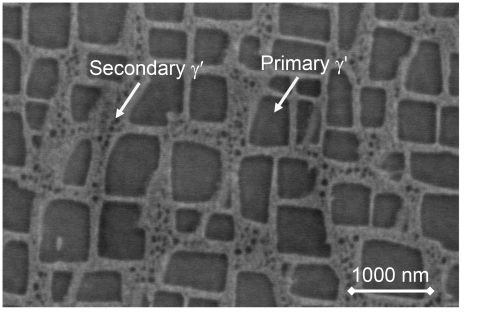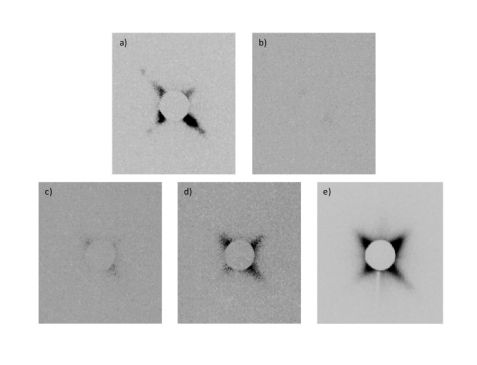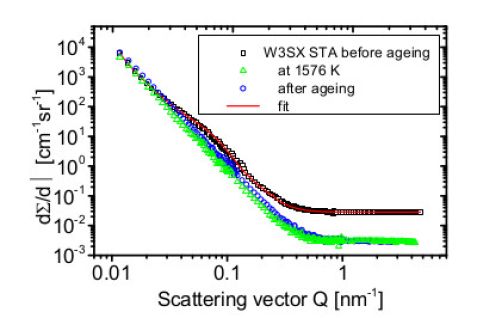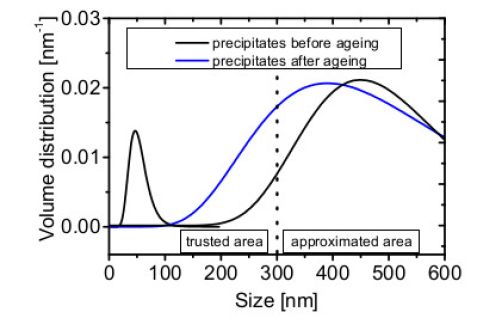MLZ ist eine Kooperation aus:
 > Technische Universität München
> Technische Universität München > Helmholtz-Zentrum Hereon
> Helmholtz-Zentrum Hereon
 > Forschungszentrum Jülich
> Forschungszentrum Jülich
MLZ ist Mitglied in:
 > LENS
> LENS > ERF-AISBL
> ERF-AISBL
MLZ in den sozialen Medien:

MLZ
Lichtenbergstr.1
85748 Garching
Studies of early stage precipitation in a tungsten–rich nickel-base superalloy using SAXS and SANS
R. Gilles1, D. Mukherji2, H. Eckerlebe3, L. Karge1, P. Staron3, P. Strunz4, and Th. Lippmann3
1Heinz Maier-Leibnitz Zentrum (MLZ), Technische Universität München, Garching, Germany
2Institut für Werkstoffe, Technische Universität Braunschweig, Braunschweig, Germany
3German Engineering Materials Science Centre (GEMS) at MLZ, Helmholtz-Zentrum Geesthacht GmbH, Garching, Germany
4Nuclear Physics Institute (NPI), Rez near Prague, Czech Republic
Characterization of early stage precipitation is an important issue as it controls the emerging microstructure developed in Ni-based superalloys. These alloys are used as single crystal blades in gas turbines. The difficulty is that the γ′ precipitation occurs at high temperatures and the reaction kinetic is extremely fast. Therefore, experimental methods with high time resolution are needed to monitor γ′ precipitation. By using the high flux synchrotron instrument HARWI-II of the Helmholtz-Zentrum Geesthacht equipped with a fast data collection detector, it was possible to observe the creation of fine precipitates and their early growth in an alloy system of a tungsten-rich Ni-base superalloy [1,2]. The cooling down of the superalloy from the single-phase region to lower temperatures already leads to the formation of γ′ precipitates in the size range of a few nm. In addition, SANS measurements were performed at the new SANS-1 instrument at MLZ to extend the results to larger precipitate sizes and to include initial growth [3].
Tungsten rich Ni-based superalloy for high temperature application
An experimental single crystal alloy (nominal composition: Ni – 11.6 Al – 2.4 Ta – 3.5 W – 6.0 Cr – 1.3 Mo in at. %) was used for this study. The samples were prepared in solution heat-treated 1533 K/5 h/argon quenched and aged 1373 K/4 h + 1173 K/24 h/air cooled condition (designated W3SX STA). The microstructure of the alloy in the heat-treated condition is shown in Fig. 1. It can be seen that the γ′ precipitates exist in two different morphologies after the heat treatments – namely, as large cuboidal particles (in the order of 400 nm to 500 nm) with rather sharp corners, which are arranged in a cubic array, and finer secondary γ′ precipitates (< 100 nm) in the γ channels with more rounded corners but still with a cuboidal morphology.
In-situ SAXS and SANS characterization of γ′ precipitates
The γ′ precipitation kinetics of the W3SX alloy is extremely fast. A very fast quenching (at the rate of 750 K/min) from 1557 K was therefore adopted for the in-situ SAXS measurement. When the alloy is cooled from the high temperature, around one second after starting the cooling process the SAXS measurement were able to monitor the early stages of γ′ nucleation (at particle sizes of ~12 nm). During these measurements, about 500 images were collected (one every 3.5 seconds) from the 2D area detector. The sequence of detector images at some critical selected temperatures during heating and cooling is shown in Fig. 2. After heating, on holding at 1557 K, γ′ precipitates (at least all the small precipitates) are dissolved. During the cooling process, the first detection of scattering from γ′ precipitates becomes visible at 1535 K. The scattering signal gets stronger due to the formation of a higher volume of precipitates on continuing cooling to RT. More details can be obtained from reference [3].
Due to furnace limitations in the SANS measurements, only much slower cooling rates (20 K/min or 60 K/min) could be achieved. Therefore, only the growth of more or less unimodal precipitates (> 400 nm) could be observed when the sample was cooled from 1573 K to RT. The size distribution of γ′ precipitates obtained from the fit of the SANS data at RT before heating is shown in Fig. 3. The average precipitate size of the small γ′ particles is 67 nm and that of the larger ones was found to be around 500 nm. The volume fractions of the two precipitate fractions are determined as 12 % for the fine cuboidal precipitates and approximately 56 % for the large cuboidal precipitates. This is in general agreement with the SEM image of the W3SX STA alloy (Fig. 1), although the size distribution and volume fraction of the large precipitates is not completely resolved by the measurement setup adopted at the SANS instrument (i.e. limited by the Q range). Hence, the size values reported can only be taken as a rough estimation. The precipitate size in the sample after in-situ ageing, measured at RT, shows an average size of slightly less than 400 nm with the precipitate size distribution more or less unimodal. It should be pointed out that continuous cooling during the in-situ cycle in the SANS experiment and the lack of holding at an ageing temperature prevents the nucleation of secondary γ′. The precipitating particles seem to grow rapidly after their first nucleation and already reach this large size after five minutes of continuous cooling.
Acknowledgement
The authors would like to thank DFG for financial support for the Co-Re alloy development project (RO 2045/31-1 and GI 242/4-1) and the Helmholtz Zentrum Geesthacht for providing beam time at the former beamline HARWI II at DESY and Torben Fischer (HZG) for supporting the experiment. Our thanks are also due to the Maier-Leibnitz Zentrum for beam time and the support of the sample environment. One of the authors (Pavel Strunz) gratefully acknowledges the support by GACR (CZ) project No. 14-36566G.
References:
[1] D. Mukherji et al., Mater. Sci. Forum 426, 815 (2003).
[2] R. Gilles et al., Advanced Materials Research 278, 42 (2011).
[3] R. Gilles et al., J. Alloy. Compd. 612, 90 (2014).
MLZ ist eine Kooperation aus:
 > Technische Universität München
> Technische Universität München > Helmholtz-Zentrum Hereon
> Helmholtz-Zentrum Hereon
 > Forschungszentrum Jülich
> Forschungszentrum Jülich
MLZ ist Mitglied in:
 > LENS
> LENS > ERF-AISBL
> ERF-AISBL
MLZ in den sozialen Medien:






